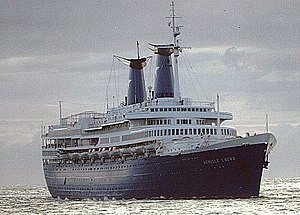MS Achille Lauro

Achille Lauro
|
|
| History | |
|---|---|
| Name: |
|
| Owner: |
|
| Operator: |
|
| Port of registry: |
|
| Ordered: | 7 May 1938 |
| Builder: | Koninklijke Maatschappij "De Schelde" Shipbuilding |
| Yard number: | 214 |
| Laid down: | 25 January 1939 |
| Launched: | 1 July 1946 (Delayed due to WWII) |
| Christened: | by HM Queen Wilhelmina |
| Completed: | 21 November 1947 |
| Maiden voyage: | 2 December 1947 |
| Out of service: | 30 November 1994 |
| Identification: |
|
| Fate: | Sank on 2 December 1994, off the coast of Somalia due to fire on board. |
| General characteristics | |
| Tonnage: |
|
| Length: | 642 ft (196 m) |
| Beam: | 82 ft (25 m) |
| Draft: | 29.3 ft (8.9 m) |
| Decks: | 9 (6 passenger accessible) |
| Installed power: |
|
| Propulsion: | 2 propellers |
| Speed: | 22.0 kn (40.7 km/h) |
| Capacity: |
|
| Crew: | 300 |
Coordinates: 2°N 47°E / 2°N 47°E
MS Achille Lauro was a cruise ship based in Naples, Italy. Built between 1939 and 1947 as MS Willem Ruys, a passenger liner for the Rotterdamsche Lloyd, she was hijacked by members of the Palestine Liberation Front in 1985.
In other incidents, she also suffered two serious collisions (in 1953 with the MS Oranje and in 1975 with the cargo ship Youseff) and four onboard fires or explosions (in 1965, 1972, 1981, and 1994). In the last of these, in 1994, the ship caught fire and sank in the Indian Ocean off Somalia.
Ordered in 1938 to replace the aging ships on the Dutch East Indies route, her keel was laid in 1939 at De Schelde shipyard in Vlissingen, Netherlands, for Rotterdamsche Lloyd (now Nedlloyd). Interrupted by World War II and two bombing raids, the ship was finally launched in July 1946, as Willem Ruys. The ship was named after the grandson of the founder of the Rotterdamsche Lloyd who was taken hostage and shot during the war.
Willem Ruys was completed in late 1947. At that time, the Rotterdamsche Lloyd had been granted a royal prefix in honor of its services during the war. Willem Ruys was 192 metres (630 ft) in length, 25 metres (82 ft) in beam, had a draught of 8.9 metres (29.2 ft), and measured 21,119 gross register tons. Eight Sulzer engines drove two propellers. She could accommodate 900 passengers. She featured a superstructure very different from other liners of that era; Willem Ruys pioneered low-slung aluminium lifeboats, within the upper-works' flanks. The next ship to adopt this unique arrangement was the SS Canberra in 1961. Today, all cruise ships follow this layout, with fibreglass-reinforced plastic (FRP) used for lifeboat hulls.
...
Wikipedia
